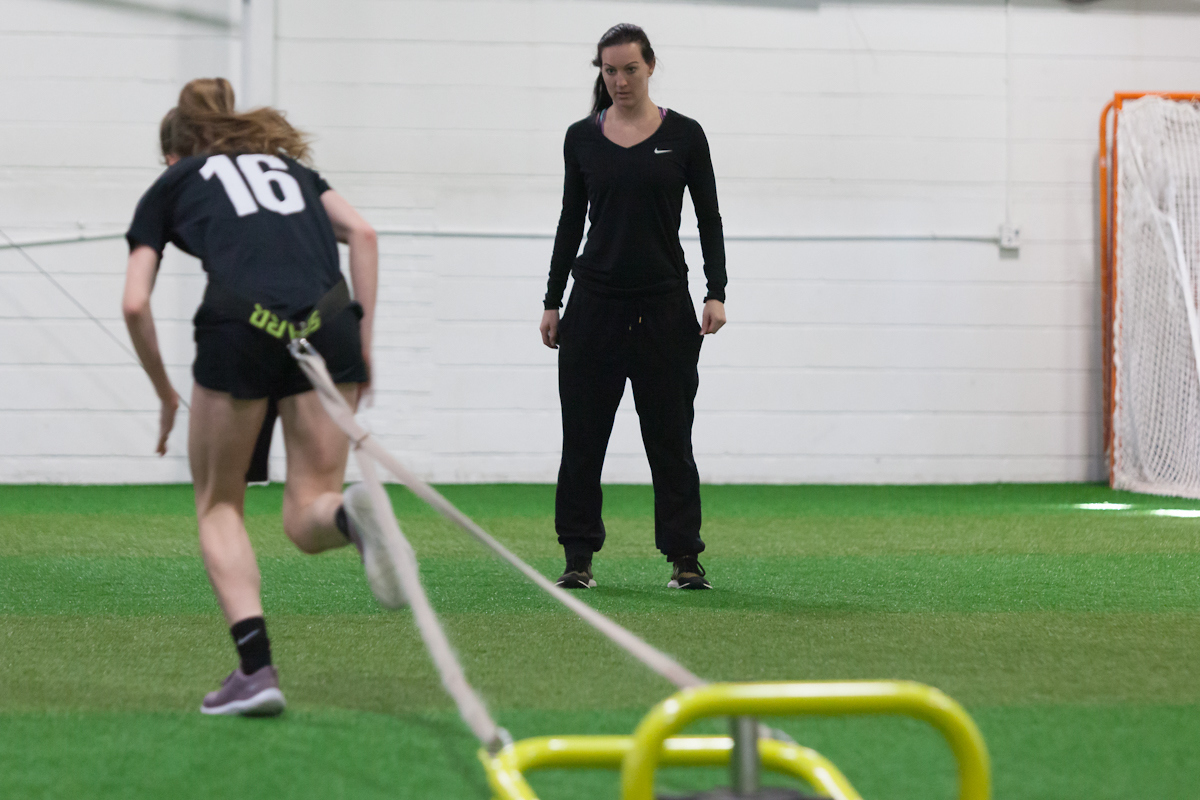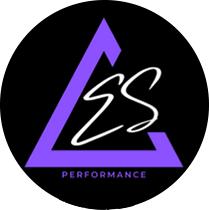
18 Apr Soccer Players: Get FAST.
There are few things I’m scared of in this world, but if I could name a handful, they are:
1. Black widows.
2. Microeconomic theory equations.
3. The Night King.

5. My blog crashing.
6. Chihuahuas with pink bows.
7. People who watch the news 8 hours a day.
8. Social isolation.
9. The guy who says ladders help with speed.
I get the last one doesn’t sound the most dramatic, but trust me, it is.
In fact, it’s terrifying.
Beware of “quick feet” gurus on Instagram – guys who fail to apply physics and principles of biomechanics, and who program drills that don’t transfer to the game, further regressing the lightning speed in our young soccer players even more.
Don’t get me wrong, quick feet drills have their place to train other energy systems and elicit a coordinative and aerobic effect.
But doing them over and over again for an hour of training? We begin to sail through rough waters.
Alas, I will go down this path later and provide some sample templates of when to sprinkle in ladder and footwork drills. For less than 15 minutes.
Newsflash: they aren’t completely useless.
Now that that’s out of the way, let’s dive into the components of speed.
Speed Is Complex
It’s not that simple.
Admittedly, I was tempted to title this piece with the usual click bait “5 Exercises to Improve Speed!” or “3 Drills To Improve First Step!” or “1 Speed Drill To Become the Next Arjen Robben and Embarrass Your Opponent!”
I wish speed were that simple. I wish there were a handful of exercises that helped. I wish there was that one solution that improved an athlete’s sprint times.
First and foremost, while I opted for a concise title to this piece “Get Fast,” don’t be fooled.
Getting faster requires working to get fast. It requires doing more than the 5 exercises you read on a strength and conditioning website. It requires you sprinting. It requires you not seeing your quick feet trainer to tap your feet through rehearsed dance drills for an hour straight.
Got it?
Good.
Let’s Talk Physics
Speed is all about producing vertical force. Can an athlete stay tall, execute an aggressive arm swing, drive the knees big rather than short, and make contact forces with the ground rapidly?
Okay, okay, maybe it’s not that complicated, but there are several problems I see in the youth soccer community:
1. Kids are not sprinting maximal speed enough.
2. Kids are not working on technique (arm action, knee drive, posture).
3. Kids are not strong enough.
4. Kids are not doing quality plyometrics, with a long recovery.
5. Kids are not reinforcing coordination and technique weekly.
6. Kids are not tracking time improvements.
7. Kids are not conditioning in a way that promotes clean running mechanics, but rather, reinforcing slow, jogging neural patterns.
Alas, I digress.
Before I go off on a tangent and down the rabbit hole of soccer players getting slow due to early specialization, added skills sessions, and lack of any real speed coaching, I want to provide actionable solutions.
So let’s revisit the problems above and give practical tips.
1. Kids are not sprinting maximal speed enough.
As speed coach Tony Holler eloquently puts, “run fast to get fast.”
And this isn’t rocket science. It’s neuromuscular science. Very rarely are soccer players exposed to the stimulus of running fast. And from a neuron firing standpoint, this is sad to say the least.
Simply put, kids need to sprint more.
Less small-sided games and touches in a small space, more vertical force production, with the sprint being no more than 5-6 seconds in length, otherwise we are getting into other energy systems and not training speed.
Funny enough, I always wonder if guru soccer speed trainers watch the game.
The player isn’t toe tapping, nor are they performing rehearsed skill work during a match. Yes, ball mastery is critical for total player development, but when we look to speed development, we have to opt for other methods.
To train full range of motion and the neural firing involved in acceleration and sprinting, get rid of the ball.
In soccer, there are more dynamic actions OFF the ball than anything.
Game changing ones, too (counterattack, through-run, diagonal ball, 1v1 victory toward goal).
Sprint FAST.
2. Kids are not working on technique (arm action, knee drive, posture) weekly.
Just like a Scissors move, speed is a skill. It involves painstaking technique and reinforcing that technique with good repetitions.
If you are the one-time-a-year goer to a week-long speed camp, just know you have to continue to apply what you learned year-round.
Technique, to that end, is neurologically driven, so what are kids doing to reinforce muscle memory with knee drive, posture, and arm swing on a regular basis?
What are kids doing to hone in on coordination and contralateral movement of the opposite arm swing, and opposite knee drive?
For most, it’s mundane to do this work.
But just know, it’s required: the daily work of mastering the basics.
Hint: something as simple as skipping can be a part of your speed day warm-up.
3. Kids are not strong enough.
The strongest athletes are able to produce the most power, and produce higher amounts of force.
Too, do kids have the strength in their hip flexors to be able to drive their knees during a sprint without strain on the low back?
Too, do kids have the co-contraction strength in their glutes and hamstrings to be able to produce vertical force without straining a hamstring?
4. Kids are not doing quality plyometrics.
Instead, coaches are tossing out high set, high rep, leaving kids feeling fatigued and defeated.
It always begs the question: what energy system are you trying to train? The fatigued-and-hates-life system?
If it’s for speed, we want to aim for low volume, high intensity and encourage athletes to “bounce” more rapidly.
Expounding further, we are tracking ground contact progress weekly:
So do your low-duration plyometrics (less than 6 seconds with a long rest >30 seconds).
Then you can all take your fast twitch muscles fibers and go home.
5. Kids are not tracking horizontal and vertical power improvements, as well as acceleration time improvements.
Want to get fast? Track everything. Compete against previous times. Train with intensity every rep.
Here’s a trajectory of athlete improvements from the past year training:
Athlete 1
Broad Jump: 5’5″ (2019) 6’8″ (2020)
10-Yard Sprint: 1.85 (2019), 1.81 (2020)
20Yard Sprint: 3.48 (2019), 3.12 (2020)
Vertical: 19.1 (2019), 20.2 (2020)
Pull-Up: 0 (2019), 3 (2020)
Athlete 2:
Broad Jump: 6’5″ (2019) 7’4″ (2020)
10-Yard Sprint: 1.82 (2019), 1.80 (2020)
20Yard Sprint: 3.39 (2019), 3.10 (2020)
Vertical: 19.3 (2019), 21.6 (2020)
Pull-Up: 3 (2019), 7 (2020)
Athlete 3:
Broad Jump: 6’4″ (2019) 7’0″ (2020)
10-Yard Sprint: 1.92 (2019), 1.81 (2020)
20 Yard Sprint: 3.32 (2019), 3.12 (2020)
Vertical: 19.5 (2019), 24.5 (2020)
Pull-Up: 0 (2019), 2 with weight (2020)
Let’s look at 40-yard times over just a few months of consistent strength, speed and power training 4x a week:
Athlete #1
Month 1 Block: 40-yard 5.04 seconds
Month 2 Block: 40-yard 4.98 seconds
Athlete #2
Month 1 Block: 40-yard 5.01 seconds
Month 2 Block: 40-yard 4.99 seconds
Athlete #3
Month 1 Block: 40-yard 5.08 seconds
Month 2 Block: 40-yard 5.00 seconds
It’s worth mentioning that these improvements were months in the making. These athletes showed up, didn’t miss workouts, and diligently competed against themselves and tracked progress. No one expected it to be easy.
Because speed isn’t. It takes work like everything else.
So if you know a soccer player who longs for lightning speed, yet they aren’t taking consistent action to improve or track it meticulously, it’s a devastating loss on their end.
They will end up stagnating and hitting a wall in their speed development.
It’s the harsh truth.
7. Kids are not conditioning in a way that promotes clean running but rather, reinforcing slow, jogging neural patterns.
Stop jogging laps. Stop. Seriously.
Several research studies allude to higher intensity work (anaerobic), as well as strength training work, improving aerobic fitness. Go HERE, HERE, and HERE.
To that end, doing more endurance won’t make you fast.
But doing more speed and high intensity, will help with endurance.
Here are timed miles from athletes solely under a tempo run and high intensity conditioning program for three months (never did long distance running):
Athlete #1
300-yard shuttle: 58 seconds
Timed mile: 6:00
Athlete #2
300-yard shuttle 57 seconds
Timed mile: 5:50
Athlete #3:
300-yard shuttle: 53 seconds
Timed mile: 5:30
To condition to play the full match, while also reaching clean, sprinting mechanics, do this:
“But what about the aerobic energy system?” you ask.
Given kids are warming up at practice with purpose (an extensive dynamic warm-up that lasts 10-15 minutes), doing their skills training for an hour a session with non-stop movement, or doing their strength training circuit style, they’re getting an aerobic effect.
As Strength Coach Michael Boyle says, “fill your buckets.”
Do they need more in the aerobic bucket?
Or do they need more in the high intensity and speed bucket?
“Know your audience,” he reiterates.

So for the soccer community, I urge you to stay FAST.
And as promised, if you are going to use ladder drills, do them in your warm-up to work on coordination and get the nervous system excited. All good in my book.
Sample Speed Day:
Ladder Warm-Up + Dynamic Stretch (10 minutes)
Explosive Hops <3 seconds duration, 2 sets each foot
10-yard Accel x2
20-yard Accel x2
30-yard Sprintx2
Start linearly, then get more specific to side shuffle, turning, back pedaling, feet chopping and curved running starts.
Rinse and repeat year-round with oscillation in load (sets/reps) depending on game schedules.
Stay coordinated.
Reinforce technique.
Run fast a few times a week.
Oh!
And don’t wither away because of useless jogging, Indian laps, a lack of strength and speed training, and the laziness to put effort into year-round speed development.
If players want to get fast, they have to do the work to get fast.
If you enjoyed this article and found it valuable, inspirational, and impactful, you can leave a creative tip HERE.
If you enjoyed this piece and want more specific structure to your speed and conditioning drills, get Total Youth Soccer Fitness 365 when it releases April 24th, 2020.


Featured Fitness Content: Volume 60 – Ruthless Performance
Posted at 10:04h, 23 April[…] Soccer Players: Get FAST. By Erica Suter […]